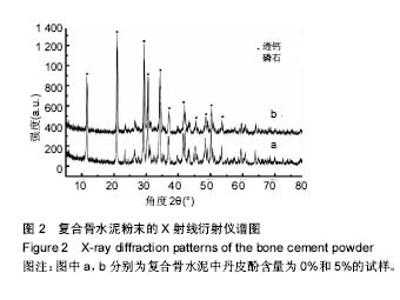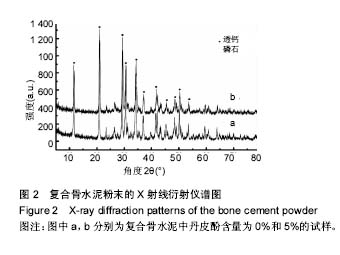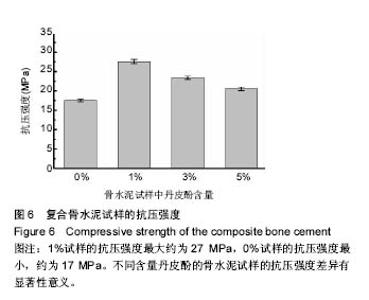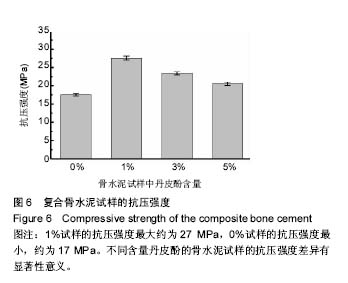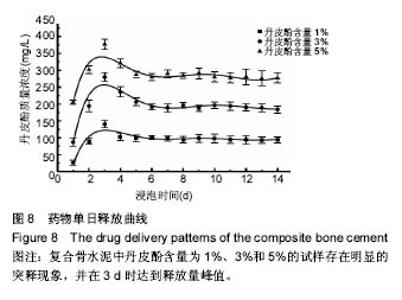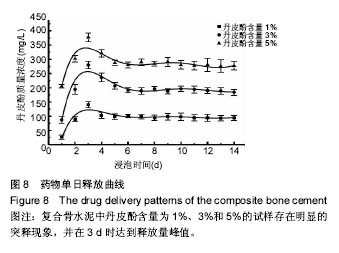Chinese Journal of Tissue Engineering Research ›› 2018, Vol. 22 ›› Issue (10): 1499-1505.doi: 10.3969/j.issn.2095-4344.0815
Previous Articles Next Articles
Preparation and characterization of paeonol loaded brushite calcium phosphate cement
- 1Central Lab, Beijing Shijitan Hospital, Capital Medical University, Beijing 100038, China; 2College of Medical Technology and Engineering, 3College of Material Science and Engineering, Henan University of Science and Technology, Luoyang 471023, Henan Province, China
-
Received:2017-11-23Online:2018-04-08Published:2018-04-08 -
Contact:Li Guang-da, Ph.D., Associate professor, Master’s supervisor, College of Medical Technology and Engineering, Henan University of Science and Technology, Luoyang 471023, Henan Province, China -
About author:Li Xiao-yu, Master, Central Lab, Beijing Shijitan Hospital, Capital Medical University, Beijing 100038, China College of Medical; Technology and Engineering, Henan University of Science and Technology, Luoyang 471023, Henan Province, China -
Supported by:the National Natural Science Foundation of China, No. 81402225, 21461009
CLC Number:
Cite this article
Li Xiao-yu, Li Guang-da, Zhao San-tuan, Li Yong-kai, Zhao Peng-chao, Peng Huan. Preparation and characterization of paeonol loaded brushite calcium phosphate cement[J]. Chinese Journal of Tissue Engineering Research, 2018, 22(10): 1499-1505.
share this article
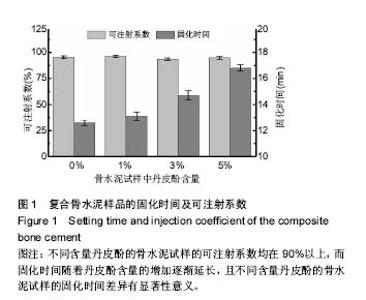
2.1 复合骨水泥的固化时间、可注射系数和物相组成 图1为骨水泥固化时间及可注射系数,从中可见,随丹皮酚含量增加,骨水泥固化时间延长,从0%试样的13 min延长到5%试样的17 min,但均在20 min以内,符合临床使用要求[24]。骨水泥的可注射系数均在95%左右,可见加入丹皮酚未对骨水泥可注射性造成显著影响。透钙磷石骨水泥固相粉末在水化时会发生如下化学反应生成透钙磷石[13]: 在试样的X射线衍射仪谱图中,在2θ约12°、21°、29.2°、30.5°、34.1°和34.4°等处观察到透钙磷石(PDF#09-0077)典型的强衍射峰,说明骨水泥反应充分,丹皮酚的加入未对材料晶相产生显著影响(图2)。各试样的红外测试结果相似,均在3 540,3 485 cm-1和3 289,3 165 cm-1处出现结晶水O-H的吸收峰,在1 651 cm-1处出现H-O-H的吸收峰,并在1 140,1 066和990 cm-1处观察到PO4基团的吸收峰[25](图3)。 从图4可以看出,各试样超微结构存在明显差异。未加入丹皮酚的样品表面为纵横交错的片状结晶,大小均匀,由于表面应力取向及视觉原因,呈针状。随着丹皮酚含量增加,结晶体逐渐变大、增厚,且形态不规则。"
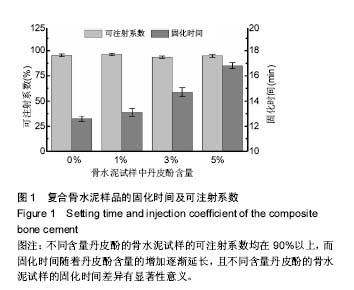
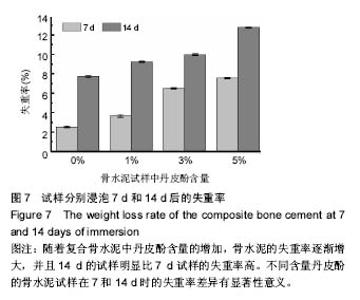
2.3 复合骨水泥的可降解性能及药物缓释性能 骨水泥材料在植入体内后,需要最终全部降解并且降解速率与骨组织新生速率相匹配,而透钙磷石骨水泥可以在体内全部降解[26]。图7为骨水泥试样浸泡7 d和14 d后的失重率。浸泡7 d的试样失重率从0%试样的2.51%增加到5%试样的7.56%,而浸泡14 d的试样的失重率从0%试样的7.71%增加到5%试样的12.77%。 随着骨水泥试样中丹皮酚含量的增加,试样的降解速度加快,并且浸泡14 d的试样的失重率明显高于7 d组。 图8为骨水泥中丹皮酚的单日释放量拟合曲线,可见载丹皮酚透钙磷石骨水泥样品浸泡入介质溶液后,溶液中药物浓度逐渐上升,第3天时,丹皮酚单日释放量达到峰值,而后药物溶出逐渐稳定。 "
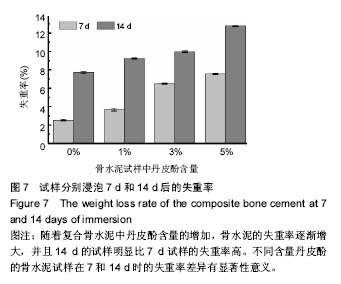
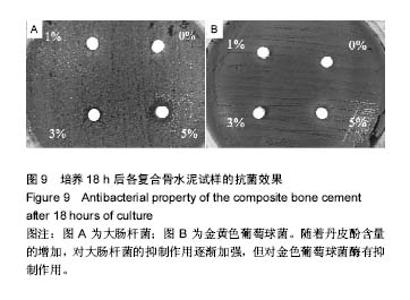
2.4 复合骨水泥的抗菌性能表征与细胞亲和性能 从图9可看出,在培养18 h后,不负载丹皮酚的骨水泥对大肠杆菌和金色葡萄球菌的生长都不具有抑制作用。而随着丹皮酚含量的增加,骨水泥对大肠杆菌的抑制作用逐渐加强,1%、3%和5%试样的抑菌圈大小分别提高到约6 mm、8 mm和 10 mm。但各试样对金色葡萄球菌却未显示出抑制生长能力。 图10为材料与细胞复合培养3 d后的材料表面微观形貌,可见在浸泡入培养基中一段时间后,各骨水泥试样的表面形貌发生了显著变化,由以前的紧密排列片状晶粒转换成了许多疏松的细小球状颗粒。众所周知,透钙磷石骨水泥降解速度较快,细胞在其上黏附性差,较难在体外观察到材料上有细胞黏附,但实验中在材料与细胞共同培养3 d后可见细胞在各材料表面的黏附。"
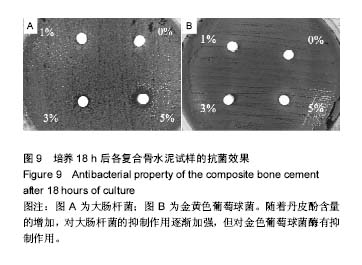
| [1]Sarkar SK, Lee BY, Padalhin AR, et al. Brushite-based calcium phosphate cement with multichannel hydroxyapatite granule loading for improved bone regeneration. J Biomater Appl. 2016;30(6):823-837.[2]Saleh AT, Ling LS, Hussain R. Injectable magnesium-doped brushite cement for controlled drug release application. J Mater Sci. 2016;51(16):7427-7439.[3]白波,吴显培,卢伟杰,等.新型可注射可降解磷酸钙骨水泥的生物相容性的实验研究[J].广州医学院学报,2006,34(1):21-25.[4]张慧勇.磷酸钙骨水泥制备方法的改进及其性能研究[J].化工科技,2015,23(6):48-52.[5]耿帅,赵育林,曾凯,等.丹皮酚的研究进展[J].中国新药与临床杂志,2016,35(5):310-313.[6]高立民,满其倩.丹皮酚抗肿瘤作用及作用机制研究进展[J].药物评价研究,2016,39(2):296-299.[7]姚瑶,冯伟红,王岚,等.活血止痛纳米凝胶贴膏经皮渗透特性及药效评价[J].中国中医药信息杂志,2017,24(2):70-75.[8]邢佰颖,朱明珠,郑浩,等.丹皮酚主要药理研究进展[J].科研,2016(11):00223.[9]吴琪,胡华,熊昌源.丹皮酚关节内注射对关节软骨影响的实验研究[J].湖北中医药大学学报,2013,15(2):18-20.[10]刘春云,武廷章,周大喜,等.丹皮酚抗菌作用的研究[J].生物学杂志,2000,17(3):23-24.[11]吴琪,任婕.丹皮酚对兔膝关节软骨细胞凋亡及相关基因的影响[J].湖北中医药大学学报,2016,18(2):11-14.[12]吴琪,何敢想,胡燕芬,等.丹皮酚致兔膝骨性关节炎软骨细胞凋亡及相关蛋白Bcl-2、Bax mRNA表达的时间与剂量效应研究[J].中国药房,2016,27(10):1337-1340.[13]Pina S, Olhero SM, Gheduzzi S, et al. Influence of setting liquid composition and liquid-to-powder ratio on properties of a Mg-substituted calcium phosphate cement. Acta Biomater. 2009;5(4):1233-1240.[14]李光大,常乔婉,赵三团,等.纳米Fe3O4对透钙磷石骨水泥的理化性能影响研究[J].功能材料,2013,44(16):2379-2383.[15]Han B, Ma PW, Zhang LL, et al. beta-TCP/MCPM-based premixed calcium phosphate cements. Acta Biomater. 2009; 5(8):3165-3177. [16]Loca D, Sokolova M, Locs J, et al. Calcium phosphate bone cements for local vancomycin delivery. Mater Sci Eng C Mater Biol Appl. 2015;49:106-113.[17]Gao CX, Liu HL, Yang HL, et al. Fabrication and Characterization of Injectable Calcium Phosphate-based Cements for Kyphoplasty. Mater Technol. 2016:1-8.[18]Bohner M, Merkle HP, Landuyt PV, et al. Effect of several additives and their admixtures on the physico-chemical properties of a calcium phosphate cement. J Mater Sci Mater Med. 2000;11(2):111-116.[19]Laurentin A, Edwards CA. A microtiter modification of the anthrone-sulfuric acid colorimetric assay for glucose-based carbohydrates. Anal Biochem. 2003;315(1):143-145.[20]Vlad MD, del Valle LJ, Poeata I, et al. Injectable iron-modified apatitic bone cement intended for kyphoplasty: cytocompatibility study. J Mater Sci Mater Med. 2008;19(12): 3575-3583. [21]吴爱武.临床微生物学与检验[M].3版.北京:人民卫生出版社, 2011:88-96.[22]Montesi M, Panseri S, Dapporto M, et al. Sr-substituted bone cements direct mesenchymal stem cells, osteoblasts and osteoclasts fate. PLoS One. 2017;12(2):e0172100.[23]Mestres G, Abdolhosseini M, Bowles W, et al. Antimicrobial properties and dentin bonding strength of magnesium phosphate cements. Acta Biomater. 2013;9(9):8384-8393. [24]Ginebra MP, Fernández E, De Maeyer EA, et al. Setting reaction and hardening of an apatitic calcium phosphate cement. J Dent Res. 1997;76(4):905-912.[25]Cama G, Barberis F, Botter R, et al. Preparation and properties of macroporous brushite bone cements. Acta Biomater. 2009;5(6):2161-2168.[26]Engstrand J, Persson C, Engqvist H. The effect of composition on mechanical properties of brushite cements. J Mech Behav Biomed Mater. 2014;29:81-90.[27]高昊辰,吴鉴今,曹志中.磷酸钙骨水泥生物学特性及在口腔学应用中的研究进展[J].医学研究生学报,2015,28(8):880-884.[28]陈威,吴清平,张菊梅,等.壳聚糖抑菌机制的初步研究[J].微生物学报,2008,48(2):164-168.[29]卢亢,陈泽楚,李婷,等.壳聚糖的制备及其抑菌性能的研究[J].离子交换与吸附,2015,31(2):178-186.[30]刘晶,胡杨,沈玉凤,等.壳聚糖与海藻酸钙双相陶瓷骨支架的机械性能及细胞相容性[J].中国组织工程研究,2016,20(8): 1104-1110.[31]杨迪诚,钟建,刘涛,等.透钙磷石骨水泥制备及其载药性能[J].中国组织工程研究,2015,19(3):427-433.[32]Tamimi F, Sheikh Z, Barralet J. Dicalcium phosphate cements: brushite and monetite. Acta Biomater. 2012;8(2):474-487.[33]Kawashita M, Kawamura K, Li Z. PMMA-based bone cements containing magnetite particles for the hyperthermia of cancer. Acta Biomater. 2010;6(8):3187-3192.[34]Wu F, Wei J, Guo H, et al. Self-setting bioactive calcium-magnesium phosphate cement with high strength and degradability for bone regeneration. Acta Biomater. 2008; 4(6):1873-1884. [35]司南,王宏洁,边宝林.六味地黄处方饮片和不同粉碎条件下微粉水提物中丹皮酚含量的比较[J].中国实验方剂学杂志,2005, 11(6):28-29.[36]蒋丽丽,张彦龙,王春杰,等.牡丹皮中有效成分丹皮酚的药理活性研究进展[J].现代诊断与治疗,2016,27(22):4223-4224.[37]刘强,刘文彬,张玉芳,等.丹皮酚的酮基衍生物及其药理活性研究进展[J].湖南中医药大学学报,2015,35(2):56-59.[38]肖坚,毛兆光,朱慧华,等.抗生素骨水泥联合外固定支架在下肢开放性骨折骨缺损中的早期应用[J].中国骨伤,2017,30(3): 270-273.[39]胡必军,黄志明,熊涛.手术治疗胫骨平台骨折27例临床分析[J].检验医学与临床,2015,12(z2):180-182.[40]李涛,史占军,王健,等.两种抗生素复合骨水泥的材料学性能及抗菌活性研究[J].中华关节外科杂志:电子版,2016,10(4):407-412.[41]宋丹.丹皮酚体外抑菌作用研究[J].医药导报,2012,31(9): 1135-1137. |
| [1] | Zhang Tongtong, Wang Zhonghua, Wen Jie, Song Yuxin, Liu Lin. Application of three-dimensional printing model in surgical resection and reconstruction of cervical tumor [J]. Chinese Journal of Tissue Engineering Research, 2021, 25(9): 1335-1339. |
| [2] | Zeng Yanhua, Hao Yanlei. In vitro culture and purification of Schwann cells: a systematic review [J]. Chinese Journal of Tissue Engineering Research, 2021, 25(7): 1135-1141. |
| [3] | Xu Dongzi, Zhang Ting, Ouyang Zhaolian. The global competitive situation of cardiac tissue engineering based on patent analysis [J]. Chinese Journal of Tissue Engineering Research, 2021, 25(5): 807-812. |
| [4] | Wu Zijian, Hu Zhaoduan, Xie Youqiong, Wang Feng, Li Jia, Li Bocun, Cai Guowei, Peng Rui. Three-dimensional printing technology and bone tissue engineering research: literature metrology and visual analysis of research hotspots [J]. Chinese Journal of Tissue Engineering Research, 2021, 25(4): 564-569. |
| [5] | Chang Wenliao, Zhao Jie, Sun Xiaoliang, Wang Kun, Wu Guofeng, Zhou Jian, Li Shuxiang, Sun Han. Material selection, theoretical design and biomimetic function of artificial periosteum [J]. Chinese Journal of Tissue Engineering Research, 2021, 25(4): 600-606. |
| [6] | Liu Fei, Cui Yutao, Liu He. Advantages and problems of local antibiotic delivery system in the treatment of osteomyelitis [J]. Chinese Journal of Tissue Engineering Research, 2021, 25(4): 614-620. |
| [7] | Li Xiaozhuang, Duan Hao, Wang Weizhou, Tang Zhihong, Wang Yanghao, He Fei. Application of bone tissue engineering materials in the treatment of bone defect diseases in vivo [J]. Chinese Journal of Tissue Engineering Research, 2021, 25(4): 626-631. |
| [8] | Zhang Zhenkun, Li Zhe, Li Ya, Wang Yingying, Wang Yaping, Zhou Xinkui, Ma Shanshan, Guan Fangxia. Application of alginate based hydrogels/dressings in wound healing: sustained, dynamic and sequential release [J]. Chinese Journal of Tissue Engineering Research, 2021, 25(4): 638-643. |
| [9] | Chen Jiana, Qiu Yanling, Nie Minhai, Liu Xuqian. Tissue engineering scaffolds in repairing oral and maxillofacial soft tissue defects [J]. Chinese Journal of Tissue Engineering Research, 2021, 25(4): 644-650. |
| [10] | Xing Hao, Zhang Yonghong, Wang Dong. Advantages and disadvantages of repairing large-segment bone defect [J]. Chinese Journal of Tissue Engineering Research, 2021, 25(3): 426-430. |
| [11] | Chen Siqi, Xian Debin, Xu Rongsheng, Qin Zhongjie, Zhang Lei, Xia Delin. Effects of bone marrow mesenchymal stem cells and human umbilical vein endothelial cells combined with hydroxyapatite-tricalcium phosphate scaffolds on early angiogenesis in skull defect repair in rats [J]. Chinese Journal of Tissue Engineering Research, 2021, 25(22): 3458-3465. |
| [12] | Wang Hao, Chen Mingxue, Li Junkang, Luo Xujiang, Peng Liqing, Li Huo, Huang Bo, Tian Guangzhao, Liu Shuyun, Sui Xiang, Huang Jingxiang, Guo Quanyi, Lu Xiaobo. Decellularized porcine skin matrix for tissue-engineered meniscus scaffold [J]. Chinese Journal of Tissue Engineering Research, 2021, 25(22): 3473-3478. |
| [13] | Mo Jianling, He Shaoru, Feng Bowen, Jian Minqiao, Zhang Xiaohui, Liu Caisheng, Liang Yijing, Liu Yumei, Chen Liang, Zhou Haiyu, Liu Yanhui. Forming prevascularized cell sheets and the expression of angiogenesis-related factors [J]. Chinese Journal of Tissue Engineering Research, 2021, 25(22): 3479-3486. |
| [14] | Liu Chang, Li Datong, Liu Yuan, Kong Lingbo, Guo Rui, Yang Lixue, Hao Dingjun, He Baorong. Poor efficacy after vertebral augmentation surgery of acute symptomatic thoracolumbar osteoporotic compression fracture: relationship with bone cement, bone mineral density, and adjacent fractures [J]. Chinese Journal of Tissue Engineering Research, 2021, 25(22): 3510-3516. |
| [15] | Liu Liyong, Zhou Lei. Research and development status and development trend of hydrogel in tissue engineering based on patent information [J]. Chinese Journal of Tissue Engineering Research, 2021, 25(22): 3527-3533. |
| Viewed | ||||||
|
Full text |
|
|||||
|
Abstract |
|
|||||
